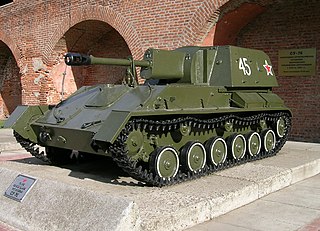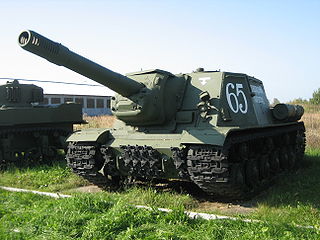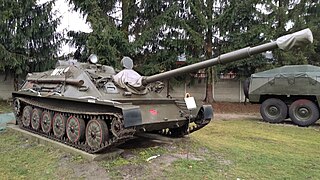
An anti-aircraft vehicle, also known as a self-propelled anti-aircraft gun (SPAAG) or self-propelled air defense system (SPAD), is a mobile vehicle with a dedicated anti-aircraft capability.

The SU-76 was a Soviet light self-propelled gun used during and after World War II. The SU-76 was based on a lengthened version of the T-70 light tank chassis and armed with the ZIS-3 mod. 1942 76-mm divisional field gun. Developed under the leadership of chief designer S.A. Ginzburg (1900–1943). Its quite simple construction and multipurpose combat role made it the second most produced Soviet armored fighting vehicle of World War II, after the T-34 medium tank.

The SU-122 was a Soviet self-propelled howitzer or assault gun used during World War II. The number "122" in the designation represents the caliber of the main armament, a 122 mm M-30S howitzer. The chassis was that of the T-34.

The SU-85 was a Soviet self-propelled gun used during World War II, based on the chassis of the T-34 medium tank. Earlier Soviet self-propelled guns were meant to serve as either assault guns, such as the SU-122, or as tank destroyers; the SU-85 fell into the latter category. As with the other AFVs in the SU series, the designation "85" refers to the vehicle's main armament, the 85 mm D-5T gun.

The ISU-152 is a Soviet self-propelled gun developed and used during World War II. It was unofficially nicknamed Zveroboy in response to several large German tanks and guns coming into service, including Tigers and Panthers. Since the ISU-152's gun was mounted in a casemate, aiming it was awkward, and had to be done by repositioning the entire vehicle using the tracks. Therefore, it was used as mobile artillery to support more mobile infantry and armor attacks. It continued service into the 1970s and was used in several campaigns and countries.

The T-70 is a light tank used by the Red Army during World War II, replacing both the T-60 scout tank for reconnaissance and the T-50 light infantry tank for infantry support. The T-80 light tank was a more advanced version of the T-70 with a two-man turret—it was produced only in very small numbers when light tank production was abandoned. The T-90 self-propelled anti-aircraft gun was a prototype vehicle with twin machine guns, based on the T-70 chassis.

The ZSU-57-2 Ob'yekt 500 is a Soviet self-propelled anti-aircraft gun (SPAAG), armed with two 57 mm autocannons. 'ZSU' stands for Zenitnaya Samokhodnaya Ustanovka, meaning "anti-aircraft self-propelled mount", '57' stands for the bore of the armament in millimetres and '2' stands for the number of gun barrels. It was the first Soviet mass-produced tracked SPAAG after World War II. In the USSR, it had the unofficial nickname Sparka, meaning "twin mount," referring to the twin autocannon with which the vehicle is armed.

The T-60 scout tank was a light tank produced by the Soviet Union from 1941 to 1942. During this period, 6,292 units were built. The tank was designed to replace the obsolete T-38 amphibious scout tank and saw action during World War II.
Samohodnaya Ustanovka may refer to any of these Soviet casemate self-propelled guns:

The ASU-85 is a Soviet-designed airborne self-propelled gun of the Cold War era. From 1959, it began to replace the open-topped ASU-57 in service. It was, in turn, replaced by the BMD-1 beginning in 1969.

Marksman is a British short range air defense system developed by Marconi, consisting of a turret, a Marconi Series 400 radar and two Swiss Oerlikon 35 mm anti-aircraft autocannons. It is similar to the German Gepard system in terms of engine performance, ammunition carried and effective range of the ammunition.

The 40M Nimród was a World War II Hungarian self-propelled anti-aircraft gun based on a license-built copy of the Swedish Landsverk L-62 Anti I SPAAG but with a new turret, and developed independently. Originally, it was intended to be used both in the anti-aircraft and tank destroyer roles, but it proved to be ineffective against heavily armored Soviet tanks like the KV-1. Therefore, it was primarily used against lightly armored vehicles and for air defense.

The SPG Kalina is a heavy, multi-purpose armoured personnel carrier designed at the OBRUM and is produced by the Bumar Łabędy company - part of Polish military consortium - Bumar Group. SPG is a development of the joint Poland, Soviet Union and East Germany transporter called MT-S, developed in the late 1980s.

The ZSU-23-4 "Shilka" is a lightly armored Soviet self-propelled, radar-guided anti-aircraft weapon system (SPAAG). It was superseded by the 2K22 Tunguska.

The M19 multiple gun motor carriage (MGMC) was a World War II United States Army self-propelled anti-aircraft weapon on the M24 light tank chassis. It was equipped with two Bofors 40 mm guns. It was produced by Cadillac and Massey Ferguson of Canada near the end of 1944.

The SU-100P is a Soviet experimental 100-mm self-propelled howitzer, and is designed by OKB-3 of the heavy machine construction division of Uralmash. The main designer of the SU-100P is Lev Gorlitsky. The SU-100P was intended to suppress and destroy enemy firing positions, engage enemy armored vehicles, as well as area denial, in addition to conducting counter-battery tasks. It was intended to be the main competitor of the Object 416.

The ZSU-37-2Yenisei was an experimental self-propelled anti-aircraft gun developed in the Soviet Union in the late 1950s. It employed dual 37 mm caliber autocannons with a combined rate of fire of 1048 rounds per minute. After trials the project was halted in 1962 and was not put into serial production.

The Object 416 is a Soviet prototype self-propelled artillery. It never went beyond prototype stage. It was intended to be a low profile tank destroyer.

















